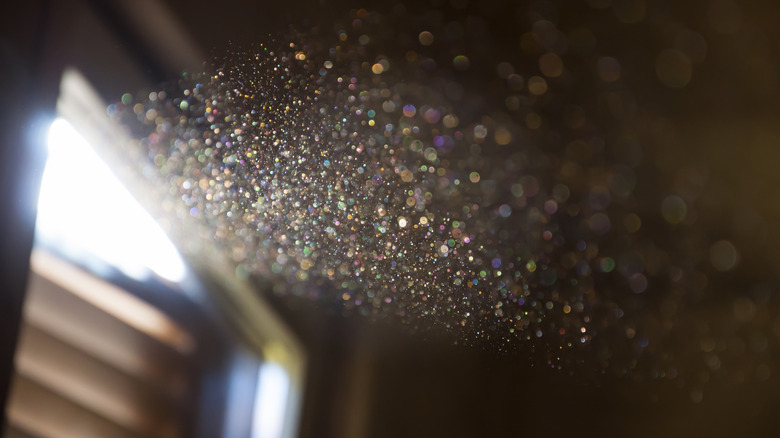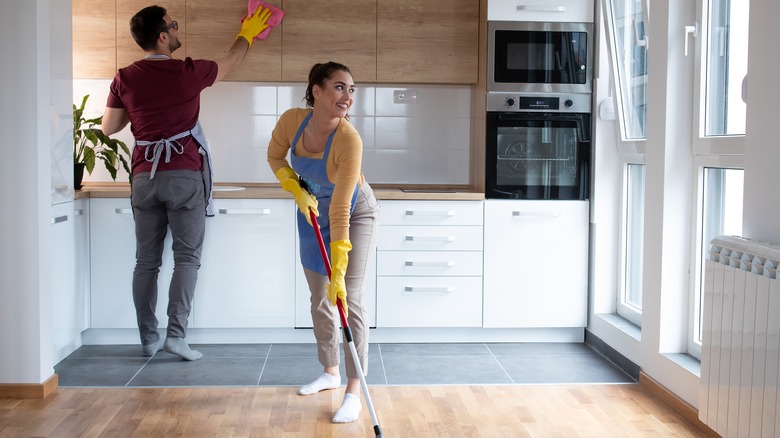The Hidden Hazards Of Built-Up Dust In Your Home (And How To Prevent It)
In today's day and age, we often worry about the effects of environmental air pollution from manufacturing, automobiles, and more. But did you know that, in most cases, the quality of indoor air is actually two to five times worse than it is outdoors (via U.S. Environmental Protection Agency)? We tend to think of dust in our homes as just... dust. We treat it like a small nuisance and try to clean it up when we can, but there's nothing wrong with a little dust in the air, right?
Unfortunately, living in a dusty environment could be much worse than you think. Sure, everyone's home gets a little dingy from time to time, but when dust starts to get out of control, it compounds on itself. Before long, you've got a major issue on your hands that's hard to remove from your home and dangerous for your health. Learn more about the hidden dangers of having dust in your home and what you can do to reduce its impact.
Little particles, big problems
Dust isn't just some amorphous collection of specks; it's actually much grosser than we like to remember. Dust is mostly made up of dead skin, dust mites, mold spores, pet dander, pollen, ash, soot, insect parts, clothing fibers, construction materials, bacteria, and viruses. In older homes, dust can even have high concentrations of lead particles shed from old paint. Dust also acts as a Trojan horse, carrying toxic chemicals like phthalates, phenols, and artificial fragrances. According to the Environmental Protection Agency, humans spend as much as 90% of their time indoors, so we're almost constantly breathing in these particles.
As you might imagine, breathing in dust can cause a handful of health issues. According to the Centers for Disease Control, symptoms of heavy particle pollution can include eye, lung, and throat irritation, poor sleep, trouble breathing, and even lung cancer or heart attacks. Dust is especially irritating to babies, older folks, people with lung conditions, and pets, who spend most of their time on the dusty floor.
Dust isn't just bad for you and your loved ones, it's rough on your home too. When dust collects in air ducts, your HVAC system has to work harder to heat and cool your home. Filters clogged with dust prevent clean air from passing through, making problems worse. Dust also has a kind of sticky quality, building upon itself exponentially until it forms thick, furry layers on your furniture, walls, and air vent.
How to decrease dust in your home
One obvious way to reduce dust in your home is to clean furniture and surfaces frequently. Depending on the size of your home, you may need to dust more or less often, but most people should aim to dust at least once per week. The method you use to dust is just as important as frequency; invest in microfiber cleaning cloths or use dampened rags to dust your home, as these will actually capture dust instead of just kicking it up into the air. After dusting, vacuum, sweep, and mop your floors, and remember to change your air filters at least once every six months or as directed on the package.
In addition to regular cleaning and maintenance, consider making some long-term changes to improve the air quality in your home. First, replace carpets with tile, wood, or laminate flooring, as rugs tend to trap dust and kick it up every time you walk by. Second, run your bathroom vent fan after a shower to reduce the humidity in your home and prevent dust mites from multiplying in your space. If necessary, invest in a dehumidifier to keep humidity below 50%. If the dust in your home is still a serious problem after following these steps, you may need to invest in additional air purifiers and hire a professional to clean out your air ducts.


